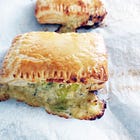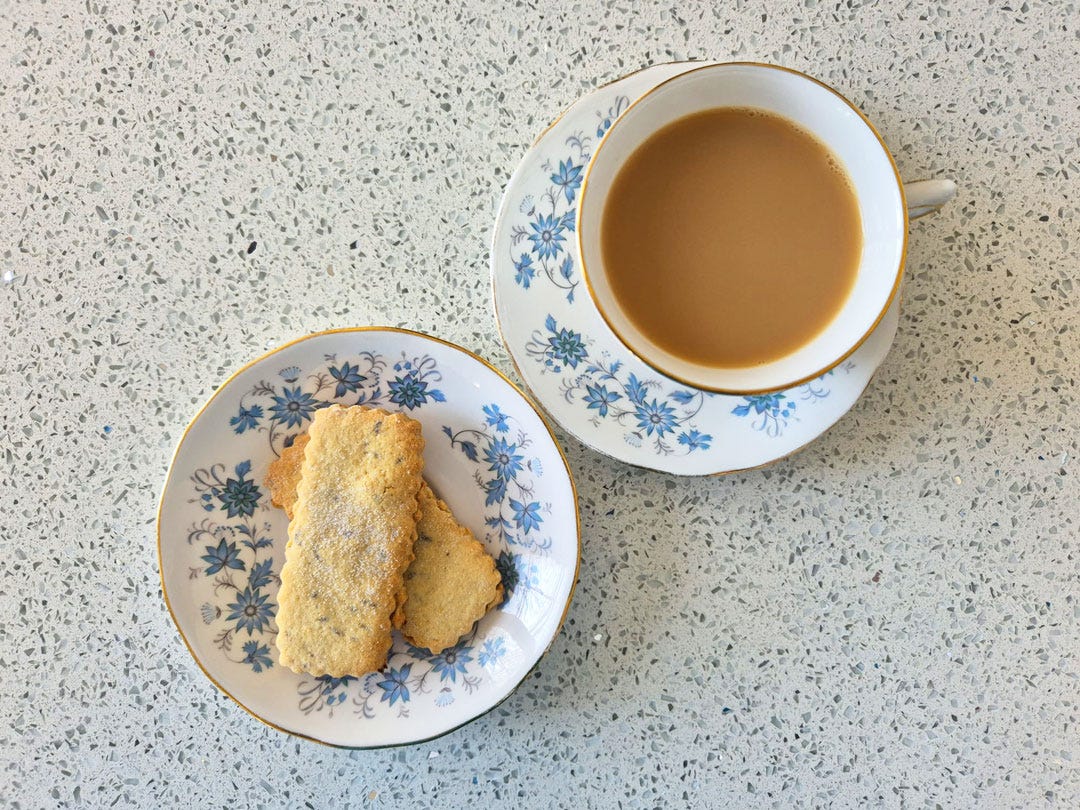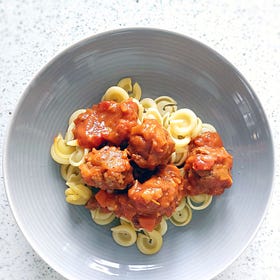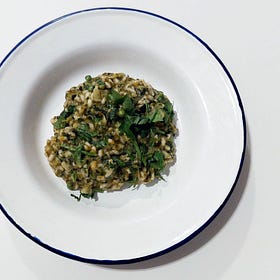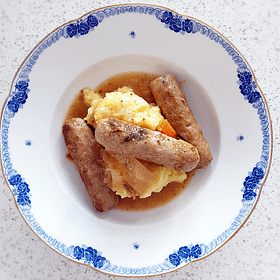A potted history of Welsh leeks
Lemon and caraway biscuits recipe
I was at an event at Europe House in London last week celebrating food from the EU. Eighteen member states showcased 40 products, from olive oil and jamón to wine to water. There was a panel discussion about food security and about GI status. That's the protection given to a product based on the place it's from, Parma ham for example. It affords the product legal protection against imitation. When the UK left the EU, it had to create its own version of the GI system. I was interested to learn that there were now discrepancies between the two registers, with some products having protected status only in the EU and vice versa. There are around 18 Welsh products on both lists including the classics such as Welsh lamb, Welsh beef and Pembrokeshire early potatoes, but more on the UKGI list. In the last fortnight, Welsh Heather Honey / Mel Grug Cymru, Pembrokeshire Rock Oysters, Pembrokeshire Native Oysters, and Dovey Native Botanical Gin were added to the UKGI list.
But what about our national vegetable? Welsh leeks currently only have UKGI protected status, and that's only been since 2022. How has it taken so long for one of our most beloved symbols and a core part of so many Welsh dishes to be recognised? It got me thinking that perhaps leeks are just leeks, and that they’re not uniquely Welsh as we all like to think. Delightfully, after some digging, I'm glad to say that leeks are in fact very Welsh and we have the history and product itself to prove it.
It's thought that the Phoenicians first introduced leeks to Wales, possibly as a trade for highly-prized Welsh tin. Leeks were lauded throughout history for their supposed medicinal properties – and they are nutrient rich – so far back as the druids.
The Romans were big on them too. Emperor Nero was known for consuming them in great quantities, earning him the nickname Porophagus – leek eater – perhaps I could now claim that moniker! He believed that leeks improved his singing voice... so maybe we finally have an explanation for why Wales produces such fine singers.
There are a multitude of legends that leeks were used in battle by the Welsh. There are tales that St. David ordered soldiers to wear leeks on their helmets in a battle against the Saxon invaders to distinguish themselves from the enemy, and it’s said that the battle itself took place in a field of leeks. In the 7th century, Cadwaladr, king of Gwynedd, also supposedly ordered his men to tie a leek to their armour. In 1346 at the Battle of Crecy, the much-feared Welsh archers are wore white and green on their battle dress. In Tudor times, there are records that soldiers wore leeks – quite possibly on St David’s Day. Even now, Welsh Guards have white and green plumes and get presented with leeks every 1 March by the royals.
In Shakespeare’s Henry V, the titular character tells Fluellen that he is wearing a leek, “for I am Welsh, you know, good countryman.”
But what makes Welsh leeks different? Well, they are a hybrid. Leeks typically like Welsh soil and it's the reason they've been grown for centuries. According to the UKGI register, “The key feature of ‘Welsh Leeks’ is their predominant long distinctive dark green flag which comprises over 40% of the overall length of the leek. The remaining stem is a light fluorescent green that becomes white only within the last 10 – 20mm when in close proximity to the root.”
Leeks also feature heavily in Welsh cookery throughout history and looking back in my library of Welsh cookbooks, they appear in many recipes including the biggies such as cawl. I’ve included a few leek recipes from the archive to celebrate this great – and definitely Welsh – vegetable.
The Recipe
Lemon and caraway biscuits
Caraway crops up a lot in old Welsh recipes, from breads to cakes. I love the slightly perfumed liquorice taste they give, and a slight citrus that pairs well with lemon. These little butter biscuits are also a bit of a take on traditional Easter biscuits – although they have currants in. I’ve made them as fingers, but you can use whatever cutter you have in your kitchen, or even an upturned wine glass.
Ingredients (makes about 20)
100g Welsh butter
75g caster sugar
1 free-range egg
Zest of a lemon
1 ½ tsp caraway seeds, slightly crushed
200g plain flour
Method
Preheat the oven 200°C/390°F/Gas Mark 6. Line a baking tray with baking paper – you might need two or to cook them in batches.
Mix the butter and sugar in a large bowl until light and smooth.
Beat in the egg a little at a time until combined.
Add the lemon zest and caraway seeds and stir together.
Mix in the flour until you have a soft dough. You might need to add a drop of milk if it’s a bit tough and or dry.
Roll out the dough on a floured surface until about the thickness of two stacked £1 coins (about 5mm), and then cut into rounds or shapes using a cutter.
Place on the baking tray and bake in the oven for 12-15 minutes until they are just starting to turn golden at the edges.
Remove and cool on a wire rack. You can dust with more caster sugar if you like. Enjoy with a strong cup of Welsh Brew tea.
If you try the recipe out, don’t forget to tag any photos with #mywelshkitchen.
The Playlist
To me, cooking and music go hand in hand, whether that’s singing at the top of your voice using a wooden spoon as a microphone while waiting for pasta to boil, or dancing around with the oven gloves on as the oven timer counts down. Here are some ideas for your Welsh Kitchen playlist.
This issue we’ve got Tra Bo Dau (While There Are Two). This lovely folk song was thought to have kickstarted the revival of Welsh folk music at the start of the 1900s, when everything was all a bit hymny, and could be a touch fire and brimstone music-wise. There’s also music from Caernarfon-born Alis Glyn, and the bossa nova tones of Malan also from North Wales.
Tra Bo Dau by Al Lewis and Casi Wyn
Golau by Alis Glyn
Dau Funud by Malan
Time to celebrate
I’m not sure how but thanks to you lovely lot in the Welsh Kitchen community, the newsletter has reached 1,000 subscribers. An enormous diolch yn fawr for taking the time to sign up, read and engage with each issue. And thank you too for all the lovely comments you send through to me. They honestly mean the world.
That’s not the only good news. The Welsh Kitchen has been shortlisted for the Wales Food & Drink Champion of the Year award at the Wales Food & Drink Awards 2025. I got interviewed by the judging panel last week who will decide the winner. The results will be announced at the awards on 22 May at Venue Cymru, Llandudno.
From the archive
A drop of pop and a glass of squash
I don’t drink fizzy drinks (sparkling wine aside). I loathe sparkling water and cannot stand soft drinks like Coke. People look at me in the same way as I look at people who say that they don’t drink hot drinks (you know who you are). I am a tea addict
Why we should eat more like children
I was sitting on the train back to Wales from London Paddington the other day and across the aisle was a toddler whose mum had just given her some little chocolate biscuits (like the animal biscuits you used to get. Can you still get these?). Her eyes lit up as the mum produced them from her bag like a magician pulling a rabbit out of a hat. Her arms re…
Homegrown herbs and hedgerows
The weather has started to change and with the first few days of sun, a literal and metaphorical cloud seems to have lifted. Blossom is in the air and on the pavements, and the heavily pruned trees are beginning to show their first green shoots. The daffodils on my balcony are still delightfully and cheerily in bloom, too.






